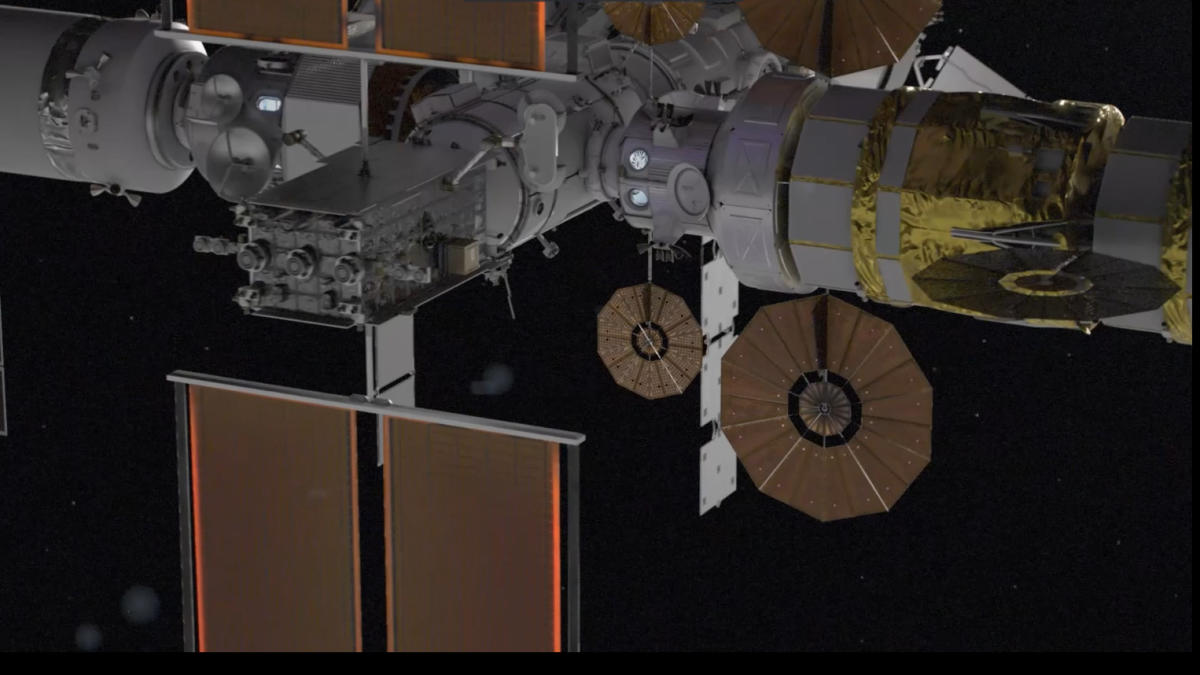Right now, engineers are busy crafting the first components of what will eventually become the Gateway space station. One day, if all goes according to plan, Gateway will serve as the first space station in lunar orbit, and the moon’s first genuine transport hub. Though it isn’t planned to be permanently inhabited, this station is being built to serve as a forward base for astronauts on Artemis moon missions through the 2030s and beyond.
And, although it may seem like a primarily NASA project, Gateway is an international effort. Europe, Japan, Canada and the United Arab Emirates are all contributing station parts.
Amid all the efforts to construct this incredible spaceborne laboratory, NASA released an artist’s 3D rendering of Gateway, showing what the station might look like if and when everything pans out — complete with all of its current planned modules. We took a closer look. Here’s what we found out.
1. HALO
At the station’s heart is the Habitation and Logistics Outpost (HALO) module, a squat cylinder that will serve as one half of Gateway’s main crew area.
Unlike the International Space Station, which orbits Earth, Gateway will not be a permanent outpost in space. Instead, it will be more like a forward base. Starting with the second crewed Artemis mission, Artemis IV, astronauts will use Gateway as an operations center, living and working aboard it when they are not walking on the moon below.
Related: NASA’s Gateway moon-orbiting space station explained in pictures
HALO, then, will be Gateway’s command and communications module. For times when Gateway is uninhabited, the module will contain software that enables the station to largely run itself. HALO will also house some of the Gateway’s science projects, such as instruments to measure radiation levels inside the module.
Also on HALO, we see the tendril of Canadarm3: a successor to the Canadian Space Agency’s iconic arm that today serves the International Space Station. When Canadarm3 is installed, it will be able to conduct repairs autonomously.
2. PPE
On HALO’s one end is Gateway’s Power and Propulsion Element (PPE). The station’s main power source, PPE will rely on a pair of roll-out solar panels to generate 60 kilowatts of electricity.
Not only will that electricity power the rest of the station’s needs, it will power the station’s electric propulsion system, located between the two solar panels. PPE will use that electricity to ionize xenon gas. Gateway will rely on that propulsion system in order to keep itself in a highly eccentric orbit that swings between 3,000 and 70,000 kilometers (1,875 and 43,750 miles) of the lunar surface.
Together, HALO and PPE will form Gateway’s initial seed. If all goes according to plan, they will reach the moon in time for Artemis IV, currently scheduled for a 2028 launch.
3. Lunar I-Hab
On HALO’s other end is a second squat cylinder, similar in size to HALO itself. This is the Lunar I-Hab. Jointly built by the European Space Agency (ESA) and the Japan Aerospace Exploration Agency (JAXA), the I-Hab will serve as Gateway’s second crew module: the second half of its crew area.
True to the “hab” in its name, I-Hab will be the crew’s living and sleeping quarters. An Artemis mission’s four crew members will share a space about the size of a caravan’s interior. The module will contain a dining galley, plus bunks and an exercise area.
Mounted on the I-Hab’s side, shaped like a bubble clinging to the module’s exterior, is an airlock that will allow crew to exit the station for spacewalks. The United Arab Emirates will provide this airlock.
Current plans call for Artemis IV to deliver I-Hab to Gateway when it flies there in 2028.
4. Lunar View
Moving back to HALO, docked to its side we see the gilt cylinder of Lunar View (known until recently as the European System Providing Refueling Infrastructure and Telecommunications, or ESPIRIT).
Another ESA-built module, Lunar View will serve as an expansion pack for the Gateway. Lunar View will only join HALO, PPE, and I-Hab on a later mission. On the current docket, that’s Artemis V, scheduled for a 2030 launch.
Lunar View is both functional and aesthetic. The functional part is the module’s primary function: extra storage. Lunar View will contain a small van’s volume of cargo, no doubt a welcome addition to HALO and I-Hab’s rather cramped quarters. The module will also contain additional fuel for PPE.
The aesthetic part comes in the form of Gateway’s largest windows. Lunar View will contain six windows, arranged around the capsule and proofed against orbital debris, allowing Gateway’s inhabitants to admire, well, a stunning view of the moon.
5. Spacecraft
More than just showing Gateway’s design, the video also shows a glimpse of what Gateway may one day look like when it is in full service as a lunar transit hub. Three spacecraft are attached to the station.
On the I-Hab’s far end is docked the Orion capsule, the mainstay of the Artemis missions and the craft that astronauts will ride to and from Earth.
The cylinder attached to I-Hab’s side is the Deep Space Logistics (DLS) cargo spacecraft, which has a specialized docking port there. Each new Artemis mission will bring one of these to Gateway with it, carrying equipment, provisions, and science experiments they will use during their time at the moon.
Lastly, attached on HALO and Lunar View’s far side is the Human Landing System (HLS) — the craft that will, starting with Artemis IV, actually bring the astronauts down to the lunar surface.
6. Science experiments
In addition to astronauts, Gateway will house a handful of science payloads. Each new Artemis mission will bring a fresh batch of experiments. NASA’s video shows two that are planned to fly on Gateway’s exterior.
Hanging on the PPE’s side is the ESA-provided European Radiation Sensors Array (ERSA), a set of instruments for measuring space radiation beyond the protection of Earth’s magnetic field. In fact, ERSA’s life will begin even before it joins Gateway, since it will measure the radiation that PPE experiences as it flies through Earth’s Van Allen belts.
— NASA’s moon-orbiting space station will be claustrophobic, architect says.
— Artemis 4 astronauts will be 1st crew to use NASA’s moon-orbiting Gateway in 2028
— Watch NASA’s next-generation lunar Gateway space station build up in concept video
Attached to HALO is NASA’s Heliophysics Environmental and Radiation Measurement Experiment Suite (HERMES), which will measure particles in Earth’s magnetotail. Essentially, as Earth is buffeted by solar wind, the magnetotail passes through the moon whenever the moon is in the right place in its orbit.
These experiments will tell us about the solar system‘s high-energy environment, to be sure. But space agencies and scientists also hope to use the information gathered by these experiments to better prepare astronauts for much longer missions, much further in the future — crewed trips to Mars, perhaps.

Dr. Sarah Adams is a scientist and science communicator who makes complex topics accessible to all. Her articles explore breakthroughs in various scientific disciplines, from space exploration to cutting-edge research.







